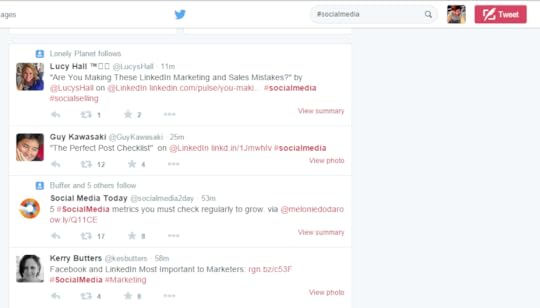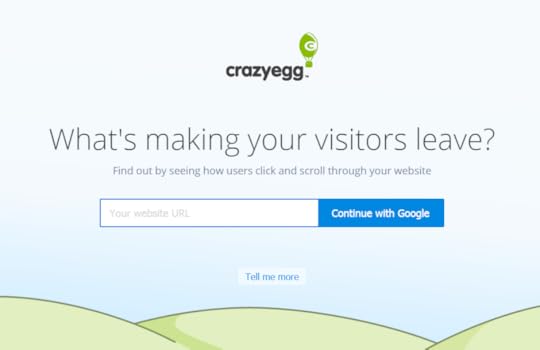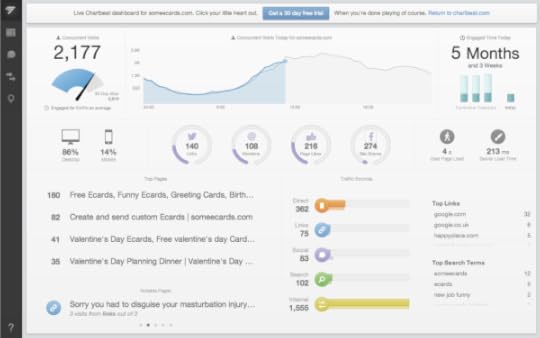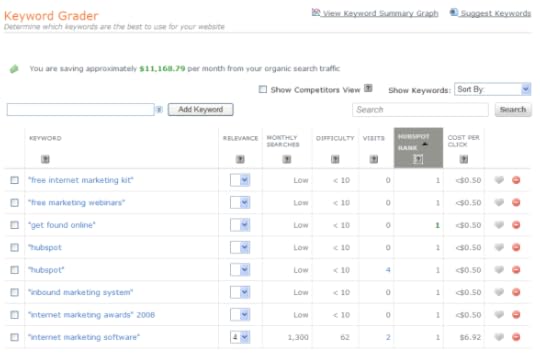Erik Qualman's Blog, page 528
July 30, 2015
Socialize Your Content Marketing Initiatives

Whether you write your own content, hire someone to do it for you or are a guest blogger for someone else, writing the content is actually only a piece of the pie.
You’ve also got to promote it, to work it, as that’s how it gets seen, shared and becomes successful.
An important part of writing content is creating shareable material. Once it’s live, the sharing starts.
And, yes, you want others to share it straight from the site, but it’s also a smart strategy for you to work on that sharing and promotion as well. Social media, among other strategies, will play a big role in this.
Share and Socialize from Day One
As the following article looks at, here are some tips and insight on sharing and socializing your content marketing:
• Share away – This is the most basic; but get your content out on all of your social media sites. Tweet it, send it on Google + and Facebook. You also have Instagram, LinkedIn, Pinterest and any other niche social media or some of the smaller sites to work with as well.
• Mention others – If you have mentioned, quoted or referenced experts in the field, mention them in your social media blurbs. It will bring more attention, maybe even a retweet or share, and then it starts all over again, possibly in a bigger way.
• Let your sources and experts know you’ve mentioned them – Don’t just do this through social media, but take a moment and send an email with the link to the content. They will probably share it on their own site and social media.
• Use YouTube – More and more people are turning to YouTube, and not just for cat videos. You can work on making your content visual, and it doesn’t have to be a “video,” it can include slides, graphics and pieces from your content to create a visual. You may break into a whole new audience.
• Include your information and other social media – When you are sharing, share about you as well. If people like your content, they’ll want to see more. In your bio, you can include your social media sites and links to other pieces related to the one you’re sharing. Be careful not to link to too much; that can be overwhelming.
• Use Sulia and Flipboard – No, they aren’t as well-known as Facebook and LinkedIn, but more people are interested in these smaller, different forms of sharing and social media.
• Include hashtags – You never know who will find you and your work with a hashtag. Be creative, but relevant, and you may hit on something great.
• Take a look at some of the big names to see what they’ve done – Companies like American Express and L’Oreal have done great, innovative work with content marketing.
Whether you are a blogger, a freelance writer or a small business owner, your content should be shared, promoted and shared again.
Use some of these strategies and see what happens!
Photo credit: Image courtesy of David Castillo Dominici at FreeDigitalPhotos.net
[image error]
The Evolution of Technology and Its Impact on Education

Technology has been amazing. Over the last decade, we have seen such a dramatic change in technology that its impact on the way we learn and the knowledge that people have, has grown immensely. It is fair to say that this generation is the most knowledgeable generation there has ever been. Previously, knowledge was confined to having access to books and tutors where the opportunity was available; and usually with a fee. The World Wide Web is responsible for providing a portal that gives people access to information and knowledge, should they choose to seek it! People are fed a staggering amount of information online. Online TAFE courses have realized this and with the trend set to continue, it is important that learning institutions cater for the different learning styles and leverage the technology that is available.
Via Flickr
Information is catered for different learning styles.
Traditionally in the classroom, we would mainly learn by listening to the teacher and through text-books. While this method is effective for some, there are many others that prefer a learning style through practical and physical learning, as well as with those that learn through visual aids. Online, information is presented in various styles that appeal to the different learning types. Furthermore, it allows people to learn more passively. Some of these styles include the ones below.
Text and audio learning through e-books
E-readers and the Kindle are linked to Amazon’s library have made access to books and information readily available to anyone that has access to an internet connection. There are books and information that covers almost any topic. And the prices for the information are relatively inexpensive.
Audio learning through podcasts
Podcasts have continued to rise in popularity over the years. It is pretty much an audio library of interest topics that people can access via their Itunes account, and they can learn whilst they are doing something else. For example, they can learn while they are driving or commuting. Their classroom expands outside of the classroom, if you know what I mean.
Visual learning through YouTube and video portals
The power of Youtube and other video portals has spurred the growth in people’s knowledge on demand. If you don’t know how to do something, you would usually go onto Youtube and learn the new skill. Then ‘viola’, you have that skill as a part of your arsenal. Typically, the skill will be a walk through with someone who is somewhat of an expert. People may even find themselves learning passively, as it is just something else that they can do in their own time.
Visual and informative learning through blogs
Blogs have been impactful on the Internet. There are blogs that provide complete walkthroughs or step-by-step guides for the topics that people want to learn about. The styles vary and can incorporate text, videos, slideshares and even infographics.
Interactive learning through smart device applications
It is amazing how much a person can learn when what they are doing doesn’t feel like it is learning. Rather, it is fun! And ideally, learning should be fun or interesting to the person. Some of the applications that have been successful in doing this include DuoLingo, the language learning application that injects fun into language lessons with daily targets. Additionally, the students can choose to progress in their language skill at their own pace. They even provide a sense of competition with a leaderboard. Applications for social networks such as Vine and Snapchat has spurred their users to become creative with their video and editing development, in order to gain as much popularity as possible. These applications provide functions that allow people to learn and express their creativity.
With the advancement in technology, we have the ability to learn practical information on demand. Learning institutions are recognising this and are introducing it into their curriculum to maximize the learning potential of their students. The mantra to work smarter and not harder definitely appeals to this generation. And technology will help them achieve that.
[image error]
July 29, 2015
Time Saving Tips for Ecommerce Store Owners

Running an ecommerce store requires that you invest a lot of time, not only into the usual business practices of management to marketing, but also in maintaining inventory and customer service.
There are certain steps that you can take to save some much-needed time while running your ecommerce store successfully, especially during busy shopping seasons, such as around the holidays. Continue reading to access a few of the top time saving tips for ecommerce storeowners.
It’s All About SEO
Like any other website and business, your ecommerce business will rely heavily upon search engine optimization (SEO) in order to rank higher in search engine results and generate higher amounts of traffic to your site. After all, high traffic means potentially higher conversions and greater profits, so it’s definitely worth your time to invest in SEO tools and techniques.
Start off by creating a Google Webmaster Tools account. Then submit your sitemap to finish setting up your account and to be sure you have everything you need to properly track your site’s traffic and analyze the effectiveness of the SEO strategies that you’re currently using.
Use Conversion Software
Conversion software from reputable companies makes it easy to do things like quickly extract PDF data and convert hundreds of pages from a PDF format to an Excel format. This is perfect for those long price lists that you often have to contend with. You can take a price list in PDF form, for example, and then convert it into an Excel spreadsheet that you can more easily edit and manage.
You can convert PDF to Excel with Cogniview, as one example, but bear in mind that there are other file conversions that you can take advantage of as well. For example, you may find it easier to convert a .jpeg file into a .pdf file, especially when it comes to working with promotional brochures or advertisements that are image-heavy.
Enhance Your Shipping
As an ecommerce business owner, you also probably spend a lot of time trying to figure out the easiest and most affordable methods for shipping your products to your customers in the timeliest fashion. In fact, this is one of the biggest challenges associated with running an ecommerce store. Thankfully, you can save time, especially when it comes to implementing efficient shipping methods.
Start by enhancing the entire shipping process by ensuring you’re able to collect order details correctly and maintain their accuracy from the start of the order to the final shipment. For example, make sure the shipping address of a customer is printed out correctly if you want them to receive their order quickly and continue purchasing from you in the future.
You can also use sites like Stamps.com to make it easier to print out shipping labels without having to leave the office. This will save you a lot of time, and it could also make it easier to keep track of how much you spend on shipping.
Once you have implemented these time saving tips, you should find that your ecommerce business flows more smoothly.
[image error]
Snapchat Replaces Yahoo and Warner Music With BuzzFeed and iHeartRadio

AdWeek – Snapchat has added BuzzFeed and iHeartRadio to its Discover portal—which lets publishers share up to 20 stories a day on the social mobile app—and Yahoo and Warner Music Group’s channels on the portal have been deleted. But the reasons for those moves are a little unclear.
“Since launching Discover with Yahoo and Warner Music six months ago, the teams have been continuously experimenting and learning what type of content works best,” Los Angeles-based Snapchat said in a statement. “Although we have new partners joining Discover today, we continue to look at different ways we can work with Yahoo and Warner Music Group on Snapchat in the future.”
A Yahoo spokesperson added: “As we continue to find unique opportunities to reach people with our content, we’re looking forward to continuing to work with partners, including Snapchat, that can bring our live video and other properties to new users.”
Snapchat launched Discover six months ago with a dozen publishers, including Daily Mail, CNN, People, ESPN and Vice, on board. As an example of how they employ Discover, Vice has been featuring “best of” content selected by its editors.
Also, Snapchat lets partners sell ads against their Discover channels while asking for 30 percent of the revenues—unless Snapchat sells the promos, in which case it would take half. It’s unlikely that the dismissal of Yahoo and Warner Music will affect those companies’ bottom lines; Snapchat advertising is still in its nascent stages. But it could be a blow if the platform matures materially for its publishing competitors—like BuzzFeed and iHeartRadio—soon.
It will be particularly interesting to watch BuzzFeed on the channel since it’s unusually dedicated to vertical video, Snapchat’s format of choice. BuzzFeed’s first post today was a clip of guys trying on women’s lingerie.
Re/code reported on July 23 that Snapchat would be adding and dismissing Discover partners.
Article by Christopher Heine for AdWeek
[image error]
Medical World Finding Social Media is a Healthy Option

Social media is everywhere.
All industries incorporate social media as a way to reach customers, clients and patients, and healthcare is no exception.
Not only is social media a smart way to reach out, but also to engage and keep costs down. It’s an affordable, easy way to market and keep patients informed and happy.
Let’s look at some of the ways hospitals, clinics and providers use social media to provide great service and disseminate information all while keeping costs down.
They include:
• Many healthcare providers have moved to scheduling and billing on their websites. It not only provides a convenience factor for both patients and providers, but also a financial savings by cutting paper and mailing costs.
• Blogs provide an excellent source of information. These can be included on the website. From general information on your practice to specific information on treatments, it’s an easy way for patients to get some information either before an appointment or as follow up.
• Social media such as Facebook and Twitter provide a venue for interaction and engagement with patients where they can leave reviews and feedback, as well as ask general questions.
• YouTube is an excellent platform where doctors and providers can share information about the practice and specific conditions. More and more patients of all ages are logging onto YouTube for this very reason.
Take the Time to Research
As the article, “5 tips for simplifying your healthcare RCM” looks at; you may find just the information that applies to your specific healthcare situation.
That can include:
• Use social media to help you out as well – Connect with other healthcare providers and learn what they are doing in the social media world. Some of their methods may work for you.
• Do it the right way – Be consistent with your social media, but don’t abuse it. Be careful of both too many posts and also of leaving your social sites alone for too long.
Social Media Should Be in Your Strategy
Social media is an integral part of any marketing strategy, and for those in the medical profession, it can provide a smart source of information.
Patients are always seeking more information, and often after an appointment is when the questions arise. Social media is a great use for this, saving time, money and even worry from patients.
It can also be a great time-saver with access to forms, scheduling and billing.
If you haven’t already employed social media, it’s probably a great time to start.
Photo credit: Image courtesy of Shutterstock
[image error]
July 28, 2015
Top 10 Online Resources for Successful Social Media Marketer


All marketers know this for a fact: their work is dependent upon the online resources they use. You have to rely on social media, ads, keywords, promotional articles, and other methods in order to make your products and services more successful. However, it’s never easy to attract many visitors and turn them into paying customers. The following 10 online tools will make that part of your work easier.
1. Kissmetrics
This is a blog focused on analytics, marketing, and testing. You will get tons of knowledge if you visit it regularly. In addition to the informative articles, you can also see great infographics that present different facts and empirical evidence about marketing trends. Kissmetrics also invites you to attend webinars that elaborate different aspects of marketing.
2. MarketingSherpa
You clearly need to be aware of all news and trends related to marketing. That’s the best way to learn which tools can make your campaign more productive. This website should be your starting point. You can regularly read new posts, statistics, graphics, and newsletter from your niche.
3. Jeffalytics
The founder of Jeffalytics is the actual designer of the Periodic Table of Google Analytics, so he is the best person to provide you with hints and tips on how to promote your brand online. You can access digital marketing resources and Google Analytics training. Some of the most popular posts include: 22 Reasons Why Your Website Sucks, The Importance of Setting Goals in Life, and The Ultimate Guide to Measuring Google Plus.
4. PapersGear
When you are too busy with your business, the online marketing campaign may suffer the consequences. Don’t let that happen! If you don’t have enough time to write content for promotional purposes, hire the professional writers at this website. You will be paired with an author specialized in your niche, and you’ll be able to collaborate with him along the completion process.
5. Marketo Marketing Blog
This blog is a better source of knowledge than all marketing textbooks you memorized during college. The featured articles are a mixture of modern and traditional marketing strategies that never fail in practice.
6. Business 2 Community
This is a platform that invites marketers to share their success stories, experience, and advice with the community. Some of them are willing to share their most effective methods, so you can definitely learn something from their practices. Of course, you can also benefit by sharing your own wisdom and discussing your campaign with these experts.
7. ReadWrite
Modern marketing is closely linked to technology, which is why you cannot stay ignorant in that area. ReadWrite provides you with news, tips, strategies, and success stories that combine technology and marketing. You’ll discover the best online and mobile marketing solutions, but you’ll also improve your overall online advertising skills.
8. TrendSpottr
This online tool gathers information from several social media websites and blogs, with the purpose of providing marketers with a list of trending topics. You can perform a localized search to see which strategies the competition has implemented. When you discover the trending topics in your niche, you can start posting something better.
9. MarketingProfs
This is mainly an informative website that features all types of articles, tutorials, tools, reports, opinions, podcasts, and seminars from the marketing niche. However, MarketingProfs is much more than that; it’s also a training platform for individuals, small teams and large teams. The live conference mode of the courses enables you to focus and learn everything you wanted to know about marketing.
10. Social Media Today
When PR people are brought together with marketing and advertising specialist, the effectiveness of one’s campaign can reach much higher levels. That’s exactly what this portal is all about. You can check out which strategies the experts are discussing. You’ll also find out about the new trends, as well as the methods you should avoid.
[image error]
July 27, 2015
Secure Video Conferencing for Business

Video conferencing, a concept only recently made possible, is changing how business communications are handled. The software suites afford businesses huge convenience, cost savings, and growth opportunities. The vast majority of businesses are already on board with video conferencing technology, but some are still worried that the technology is not secure enough to use in conjunction with sensitive information or valuable files. Especially since most high quality video conferencing suites, such as Blue Jeans, are cloud-based, they feel that hackers could breach the software’s defenses and gain access to the data. The following list summarizes some of the biggest reasons this is not actually the case. Hopefully it will convert some of the skeptics out there and even reassure some of the people already benefitting from video conferencing platforms.
Via wikipedia.org
You’ve Got the Law on Your Side – Taking significant security precautions is not something that video conferencing providers only do to greaten customer satisfaction – in fact, it’s the law. Ever since the September 11 attacks the NSA has mandated that many established organizations must have strong security put in place. This is one of the reasons that legitimate video conferencing software has several redundant levels of encryption put in place, among other extreme security measures.
128-Bit Goodness – These days, pretty much all video conferencing services use 128-bit encryption to protect the streaming video meetings and the files exchanged during those meetings from hackers. 128-bit encryption basically assigns your data a password that consists of 128 random digits and that has to be guessed to access the data. The people you authorize to access the data are given the code automatically, but hackers cannot possibly guess it. This is because a random string of 128 numbers has so many possible combinations that it would take even a super-computer 10 billion years to guess. (Note that the known universe is currently around 14 billion years old.)
Physical Encryption Keys – Many video conferencing companies provide users with physical keys or cards that must be inserted into the video conferencing hardware before multiple layers of absolutely impenetrable encryption are lifted. Quality video conferencing providers let you exchange the key whenever you want, too, as an added security measure.
Lock Down Your Data – Even once your secured meeting takes place, all of the video of the meeting and any files exchanged are archived for your future reference. Video conferencing businesses realize that keeping that sensitive business meeting information on a regular desktop or even on an external hard drive might not be safe. Because of this, reputable video conferencing companies offer their customers digital storage facilities protected by military-grade security technology.
What You Can Do
Video conferencing providers can do a lot to ensure your data is secure, but you also have to take some measures to make sure it is as safe as it can be. Some of these measures include:
Use a Firewall – It is never a good idea to put sensitive information directly on the internet, because that allows hackers to find it easily. This includes video conferencing. Instead, set up a strong firewall and put your video conferencing software behind it. It may take a few more minutes, but it is worth it if you are worried about security.
Turn Off Auto-Answer – Mike Tuchen, a video conferencing security expert, says that one of the biggest threats to video conferencing security is when people put their software on auto-answer. “It’s like if you bought a conference phone,” he explains, “and whenever anyone dialed the number it automatically picked it up and turned the phone on. There’s not a phone company in the world that would do that, but for a video conferencing company, they decided to do that, because video conferencing systems are more complex.”
Unplug When You’re Done – One prospect that worries some video conferencing users is that their systems will be hacked and their webcams will be used to spy on the office even when they are not supposed to be on. This can be very easily prevented by putting a cover over the camera’s lens when not using it or, even more effective, unplugging the system.
Don’t Turn off Encryption– For the love of all that is good, do not work against yourself by disabling any of the encryption methods put in place by the video conferencing software. Ways to disable the much-needed encryption include:
Using outdated video systems or software.
Using shoddy security services in an attempt to beef up security.
Connecting to third-party devices that don’t support encryption.
Actually going into the system settings and manually turning off encryption.
The bottom line is that, while the user can mess with the security and leave it lacking in many ways, the security measures put into place by video conferencing services are actually very good. Especially when it comes to top-tier products like Blue Jeans secure video conference software, customer security is a primary concern.
[image error]
Google reveals your location history in Maps

CNN – Google Maps is rolling out a Timeline feature that will allow users to essentially stalk themselves.
Your location has been collected and stored on Google’s servers for a long time (if you allow Google to track you), but accessing that information in the past has been difficult.
Now, the Timeline feature will be front and center in Google Maps, letting you see everywhere you’ve visited — ever.
Image from Google Lat Long via CNN
If you’re anxious about the word ‘Timeline,’ you can take some comfort in the fact that it’s not like a Facebook timeline that will be shared with all your friends. You are the only person who can view your own Google Maps Timeline history, and you can delete specific locations or your entire Timeline at your own discretion.
Think of it as a personal scrapbook where you can pick and choose which locations you want to save and memories you’d want to preserve — only you don’t have to do much to record those moments. Google will do it for you.
Now, your friends and you won’t have to argue over what bar you visited four nights ago. Just scroll through your Timeline and voila!
“We’re gradually rolling out Your Timeline, a useful way to remember and view the places you’ve been on a given day, month or year,” a post on Google’s Lat Long blog says.
In addition to location history, Google Maps will allow you to view geotagged photos from a given day right from the Maps app. You can also rename frequented spots as “Mom’s house” and “dentist,” which will show up in Google Maps.
Enabling location history also has other perks like the Now notifications, which provides information about traffic and accidents and reminds you where you parked your car.
By creating a private map, Google says it can help people get “automatic commute predictions, improved search results” and other useful information.
In the past, geotagged photos were isolated to the Photos app, and finding your location history required some deep dives into your Google account settings. Now, all that information is consolidated in one place in a user-friendly way.
People who follow a routine and visit the same places each day may engage less with the Timeline but it could be fun to be able to scroll through all the places you could never pronounce during your trip to France.
It is currently rolling out to Maps on desktops and for Android users.
Article by Ananya Bhattacharya for CNN
[image error]
Keeping Your Readers Engaged Using Social Media

31% of website traffic now comes from social media. What this should tell every e-commerce organization is that, as this trend continues, their social media accounts and pages will be the most critical sources of consumer engagement, and the single most important vehicle for getting visitors ultimately to their websites to be further engaged and, ultimately to be converted. Two major thrusts will be involved in engaging readers – the psychological aspects of appeal and solid data mining that finds and engages the right demographic.
Psychological Aspects of Engagement
Readers want several things when they use social media. They respond to content that entertains and provides humor, that shocks or puts them in awe, that connects with their “pain” and anxieties, and that appeals to their need to “belong,” and to be valued. This should drive all content that is placed on social media, once a business or organization has solid information about its typical target demographic. That demographic comprises a community, and there are then specific steps to engage community focus and maintain that engagement over the long-term. Here, then, are the specific things that research shows promote reader engagement.
Titles and Teasers: If the reader is not immediately struck by a title, nothing further will be read. Creating really catchy, quirky titles is an art, and as much time should be spent coming up with a title as with any other content. If you are not good at this, get someone who is. Another option is to try it yourself by checking out Copyblogger.com and go through their “How To” process for headlines. Basically, headlines that attract will ask questions, promote lists, give “how to’s,” state commands, or create some aura of mystery.Teasers are like headlines. You have a great blog post. You don’t want to publish it on your social media page, because you want that reader to come to your site. Putting a compelling and creative “teaser” about that design tricks for your site that will continue to engage.

Be responsive: If people are commenting on your posts or tweets, you must respond, and this can become a daily, rather arduous task. Remember, however, that your followers have an emotional need to feel important and valued. One way you do this is by engaging them in conversation and by responding to all of their comments/questions. And go further than that. If you can determine their specific interests, write a post related to it and notify them that you have done so, with a link to that post. This is part of establishing the relationship you need to convert your readers/followers.
Look at what your competitors are doing on their social media pages and accounts: What reader comments are appearing there? Address those issues with posts that you then “tease” for on your page.
Search by keyword on Twitter and learn what questions people are asking related to that keyword. Respond to those tweets with your “solutions” and invite those questioners to link over to your content.

Establish a daily compelling routine: One of the greatest ideas for using social media and for getting a regular audience that then shares your posts is to have a daily joke (readers love humor) that people will come to read every morning or evening. This may take research and some solid creativity, but it is a truly effective way to keep people coming back and spreading your brand all over the place. If you know your demographic, then your humor can match its sophistication level. One company that uses humorous posts a lot is Newcastle Beer, and a recent tweet went like this: “Today is National Beer Day. Have an ice-cold Newcastle and pretend you care.” If jokes are too difficult, find great compelling quotes or some other gimmick – even a “picture of the day.”
Use Facebook for story-telling with videos or photos of your team with personal anecdotes: This gives you a humanness that is a psychological draw.

Design you content strategy as follows: Start with emotional appeal and continue to engage while moving the reader from an emotional response to a more logical one. This is when you provide the actual content that you want the reader to have.
Combine social media and your email: Put sharing icons in your emails; ask you email subscribers to share and give them incentives to do so; put an email subscription option on your Facebook page, and given an incentive for readers to do it – a discount or a freebie.
Data Mining for Your Correct Demographic and its Behaviors
Always, the task that is the trickiest is to identify your target audience and to find them wherever they may be on social media. Google Analytics will certainly assist, but you need to go deeper. Social Data Mining will give you great information, such as:
When your target audience is online
Where your target audience is going online
Current market mood
Relevant issues of your demographic that will give you ideas for content
Competition research
Here are some tools that will help with this:
Crazy Egg: this tool will not only provide you with data on what your visitors do on your site, which is great information to have, but it will also let you know when and from where they are coming. This should drive the content that you place on your social media venues.

Chartbeat and Simplereach will give you the information of when and where your audience is. This will drive the content you post and when you post it.

Keyword Grader from HubSpot will give you great information on the best keywords, but also will track the results from each keyword you are using. You will learn which ones are driving traffic and links, so that you can use them on your social media pages and, as well, to find your competition and analyze their behaviors that are bringing in traffic.

Social Media promises to be the most important venue to drive traffic to your sight over the next several years. Your site design, you site content, and your blogs are critical too, of course, but unless the traffic is generated, they are meaningless.
[image error]
Apple, Microsoft and Google promise to do their part against climate change

Mashable – Major companies, including tech giants Apple, Microsoft and Google have teamed up with the White House to urge international governments to reach a strong climate change agreement in Paris this December.
They’re taking action. On Monday, more than a dozen large companies announced a new partnership with the White House to expand renewable energy use and cut greenhouse gas emissions and water use. The companies, which also include Cargill, General Motors, Goldman Sachs, UPS and Walmart, agreed to back a strong international climate change agreement that is to be negotiated in Paris in early December.
The Paris talks are viewed as the last chance to limit manmade global warming to an upper limit of 2 degrees Celsius, or 3.6 degrees Fahrenheit. By implication, the companies are also endorsing — or at least not objecting to — the Obama administration’s own climate goals, which are to reduce U.S. greenhouse gas emissions by 26 to 28% by 2025 compared to 2005 levels.
“No corner of the planet and no sector of the global economy will remain unaffected by climate change in the years ahead,” the fact sheet states.
By signing the “American Business Act on Climate pledge,” the companies are voicing “support for a strong outcome in the Paris climate negotiations,” according to the White House.
The corporate support for climate change action could affect the climate talks in Paris, since this is a new, influential corporate dynamic on the international stage. The tech companies who have signed on today together represent $1.3 trillion in revenue, based on 2014 data, according to a White House fact sheet.
As part of the pledge, each company agreed to take additional action to reduce their emissions.
In sum, the announcements total “at least $140 billion in low-carbon investment and more than 1,600 megawatts of new renewable energy,” the White House said.
Apple, for example, which already runs all of its U.S. operations on renewable energy, said it will bring an additional 280 megawatts of “clean power generation” online by the end of 2016 through investments in several states as well as in Sichuan Province, China.
According to the White House, Apple has cut carbon emissions from its global corporate facilities, data centers and retail stores by 48% since 2011.
Google has already committed to powering its operation with 100% renewable energy. Along those lines, it committed to tripling its renewable energy purchases by 2025.
As a company headquartered in bone dry California, Google pledged to cut its water use by 30% at its San Francisco Bay area headquarters in 2015, compared to a 2013 baseline. The company has been installing drought tolerant plants and using recycled water irrigation, among other measures, to cut water use.
“We believe that by directly investing in renewable energy projects, we can help accelerate the shift to zero-carbon power and create a better future for everyone,” the company said in the White House fact sheet.
As for Microsoft, the company also agreed with the increasingly popular tech sector pledge of purchasing 100% renewable energy for operating its data centers, offices, labs and manufacturing facilities.
The White House’s business push comes during what is expected to be the hottest year on record globally, beating the record high set just last year. June was the planet’s hottest such month since reliable instrument records began in 1880. For example, 14 of the 15 warmest years since record-keeping began in the late 1800s have occurred since the year 2000.
The companies behind the pledge are not limited to tech firms, however. Coca Cola, for example, pledged to cut “the carbon footprint of “the drink in your hand” by 25% by 2020.
Even Goldman Sachs, the Wall Street investment firm, pledged to achieve carbon neutrality “across our operations and business travel” starting this year and continuing thereafter. The company is also planning to purchase 100% renewable power for the company’s electricity needs by 2020.
Alcoa, the aluminum manufacturing giant, pledged to cut its emissions by 50% in the U.S., compared to 2005 levels, by 2025. And Berkshire Hathaway Energy, an offshoot of billionaire Warren E. Buffet’s investment firm, pledged up to $15 billion more for investments in renewable energy generation construction and operation.
In addition, Berkshire Hathaway Energy pledged to construct an addition 522 megawatts of new wind generation in Iowa and shut down more than 75% of the companies coal-fired power plants in Nevada by 2017.
Perhaps more importantly, the company pledged to invest in electrical transmission infrastructure in the West and Midwest, where most of the country’s solar and wind generation takes place, to better integrate renewable energy into the country’s electrical grid.
Because wind and solar are intermittent sources of power (the sun doesn’t always shine, and the wind doesn’t always blow), incorporating them into the standard electrical grid has its challenges.
And Walmart, which is already one of the largest users of solar energy across the U.S. and most forward-thinking companies when it comes to cutting emissions from improving fuel efficiency and reforming product packaging practices, pledged to increase its procurement of renewable energy globally by more than 600% compared to a 2010 baseline. This includes doubling the number of on-site solar energy projects at U.S. stores by 2020.
This marks a noteworthy departure from the state of climate treaty negotiations during the Obama administration’s first year in office, when many companies feared cost increases from the climate agreement etched out in Copenhagen in 2009 and showed some resistance.
The White House is planning to announce a second round of pledges in the fall, “with a goal of mobilizing many more companies to join.” And Secretary of State John Kerry will hold a forum at the State Department in October to highlight U.S. actions on climate investments and solutions.
Kerry will be on hand to make the climate pledge announcements at the White House on Monday.
In its push for a strong Paris climate agreement, the White House faces widespread and deep opposition in both houses of Congress, where many Republicans doubt the mainstream science findings on manmade global warming.
Article by Andrew Freeman for Mashable
Thumbnail from Shutterstock
[image error]







